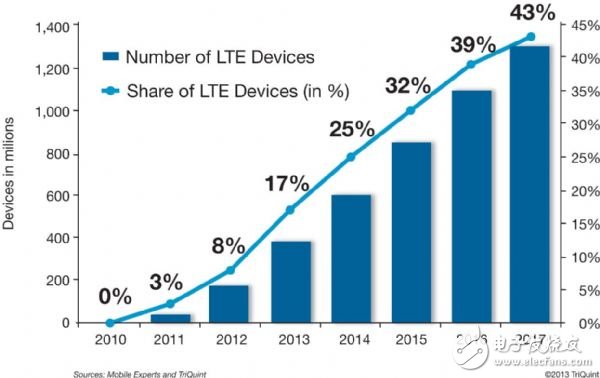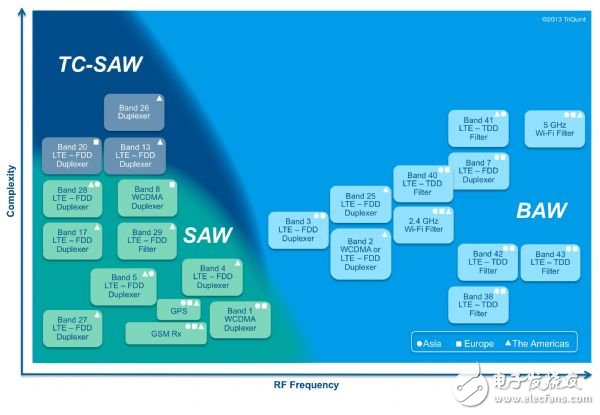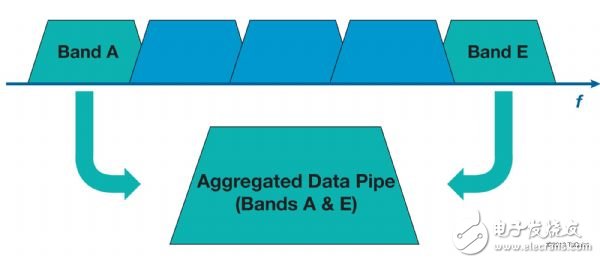Mobile communication devices have had a profound impact on our lives, and mobile communication technology has penetrated into everyone's life earlier. Only a few years ago, mobile phones were just devices for making and receiving calls. However, with the advancement of the times, most of us now have smart phones or tablets, and their functions are no less than one computer. Today, these smart devices are equipped with functions such as global positioning system, accelerometer, camera, distance sensor, near field communication technology, and gyroscope.
Our lives have been unable to leave these mobile communication devices. According to reports, 95% of people put their mobile phones within one meter of their own size all day, which means we can answer calls, read newsletters and check emails anytime, anywhere. This phenomenon has led to a significant increase in data communications. If smart phones continue to be popularized, it is expected that data traffic will be more than ten times in the next five years.

Figure 1: Forecasting LTE smartphones will grow substantially.

Figure 2: Overview of different LTE frequency segments and applicable filters.


The huge increase in traffic is due to consumers continually seeking more mobile broadband services to support Internet usage, video streaming, digital content downloads, video games and other high-bandwidth requirements, as well as data-intensive multimedia applications. These surges in demand have burdened the communications infrastructure. As a result, communications service providers around the world are updating their networks to ensure they have sufficient capacity and coverage to meet customer expectations.
As an industry leader in innovative wireless communications RF solutions and foundry, TriQuint Semiconductor offers advanced, high-performance solutions that package more functionality in a single module with a high degree of integrated expertise. It occupies a smaller size than a single individual electronic component.
In the following interviews, TriQuint discusses the company's perspectives, mobile communications and network infrastructure opportunities, and the industry's vision.
LTE technology accelerates deployment
Question 1: How does the fourth-generation LTE technology affect the wireless infrastructure?
A: The deployment of LTE allows communication service providers to transmit more data traffic more efficiently, which in turn boosts the capacity requirements of base stations to wireless network communication access points. The increase in capacity will further drive the use of large amounts of data on fiber-optic networks in the back-end network, as well as applications that connect mobile users to Internet nodes and foreign websites. LTE technology can better utilize existing spectrum, increase data transmission rate, reduce latency, reduce transmission cost per bit, and simplify network architecture. (Please refer to Figure 1)
When more LTE devices come, it will lead to a substantial increase in infrastructure investment. Currently, more than 200 LTE networks have been launched by operators around the world, and there are more plans. The speed of switching to 4G will be much faster than the industry's entry into 3G services. For example, in the Asia Pacific region, LTE is expected to cover half of its population by 2018.
At the same time, telecom operators are also offloading data traffic to small femtocells dominated by Wi-Fi technology, commonly referred to as micro-honeycombs or femto-honey network systems to mitigate excessive networks. load. In heterogeneous networks (HetNets), small-scale cellular networks will play a key role in expanding the coverage of densely populated metropolitan areas. Heterogeneous networks allow operators to combine their spectrum and optimize existing wireless network assets while giving customers a better overall experience. The emergence of a small cellular network has also allowed network services to be extended to remote areas, and its low cost has made it even profitable even in areas with low population density.
When the wireless network evolves to 4G or more advanced technologies, the bandwidth requirements of each cellular base station will increase significantly, so another challenge that operators will face is to upload large amounts of data from the micro base station to the back network. . In this regard, both fiber-optic networks and microwave radios are reasonable solutions.
Fiber optic networks offer new technologies with higher capacity, better quality and lower cost options, while microwave/point-to-point radio solutions from 9 to 27 GHz provide adequate bandwidth and distance. Fibers can now be upgraded from 10 to 40 Gb/s to 100 Gb/s or higher, while microwave radios can reach areas where fiber deployment costs are too high or too slow. TriQuint offers high-performance solutions for these deployment paths, with a high degree of integrated expertise to package more functions into a single module that is significantly smaller than a discrete solution.
Question 2: How does LTE deployment impact the smartphone market?
A: LTE construction is significantly increasing the number of frequency bands used by smart phones, which in turn poses new challenges for design engineers. In addition to meeting the urgent performance requirements, engineers also need to accommodate the number of frequency bands in mobile communication devices. The next generation of smartphones must continue to support the main 2G band, 3G band, new 4G plus Wi-Fi and Bluetooth. The 5 dedicated bands of 3G are dwarfed by at least 20 bands of 4G LTE, and the number may be expanded to 40 in the future.
Question 3: What impact does the transition to high performance filters have when LTE continues to deploy? How will it affect the market?
A: In the RF front-end module, the filter plays a key role in the ability to pass valid signals and reject invalid noise. Unlike power amplifiers (PAs) that cover multiple frequency bands, filters are band-specific, so an increase in the number of channels directly leads to an increase in the number of filters or duplexers in the device.
Although the idea of ​​a mobile phone to support all channels in the world is not practical, a mobile phone with sufficient performance and sufficient international capacity must have 2G, 3G and 4G transmission and reception channels, at least 15 channels, and Plus Wi-Fi, Bluetooth and GPS. This phone requires at least 30 to 40 filters. The future may be more complicated, and the next generation of high-end phones may require more than 50 filters.
In addition, each of the crossover multiplex and time division multiplex channels of the smart phone requires up to three filters: the main transmission path and the receiving path require a multiplexer, and another filter is required. To receive the route. Depending on the frequency band, a coexisting Wi-Fi filter is also required.
Question 4: What filter technology is required to comply with LTE performance specifications?
A: As the number of filter requirements increases, so does its performance requirements. Not only do all the bands in the device need to be isolated to avoid interference with each other, but the crowded spectrum also means that the guard bands between adjacent bands will be significantly reduced or even completely disappeared. In order to alleviate the interference problem caused by this, a high-performance filter is required. The frequency bands that are reassigned to LTE after some spectrum reforming also have different requirements for filters. For example, the narrow 5 MHz and 10 MHz 4G LTE bands require a sharper filter than 3G WCDMA.
TriQuint solves the most difficult filtering challenges with its advanced technology portfolio. Our surface acoustic wave (SAW) and temperature compensated surface acoustic wave (TC-SAW) filters are available up to 1.5 GHz, and TriQuint's bulk acoustic wave (BAW) filters have convincing performance above this frequency range. Advantage. (Please refer to Figure 2)
Our BAW technology is the only way to meet the needs of some of the most challenging LTE channels. The BAW wave filter provides excellent precision performance, including steep skirts and a high rejection spectrum with very low temperature drift, which is ideal for solving the annoying interference suppression problem between adjacent bands. The size of the BAW filter is decremented with increasing frequency, so the bulk acoustic wave filter is the best choice for 3G and 4G applications where performance and size are critical.
Impact of regional frequency band allocation
Question 5: What is the impact of regional band allocation on mobile phone design?
A: Mobile phone designers must work hard to resolve the problems caused by significant differences in frequency bands between regions and even between countries. In the future, when more LTE bands are allocated, the situation will only become more severe. For example, in Asia, the complexity of LTE band allocation is due to the regional band allocation in several different regional markets; the mainland is a vast potential market, but has its special needs. Other countries, such as Japan and South Korea, which are the two most active 4G LTE countries, also have their own needs.
In the mainland, the LTE technology it specifies is time-division multiplex, not the crossover multiplex used in North America. Many LTE bands are distributed in the high frequency band, including many adjacent Wi-Fi bands. This situation creates a strong demand for BAW Wi-Fi coexistence filters. For example, as shown in FIG. 3, two immediately adjacent LTE time-multiplexed channels located in bands 40 and 41 can be found. (Please refer to Figure 3).
The Wi-Fi channel sandwiched between the two channels has no gap below the band 40, and there is only a minimum gap between the top and the band 41. A high performance BAW coexistence filter will be needed. In addition, it is necessary to make trade-offs based on customer priorities; to support Band 40 full-band, you may need to give up some low-frequency Wi-Fi channels. If all Wi-Fi bandwidth is a priority, some vendors will choose to discard part of the band 40. Since there is a narrow guard band between the band 41 and the adjacent Wi-Fi, the coexistence of the band 41 is less challenging. Even in the mainland, there are regional differences. For example, in Hong Kong, band 41 is replaced by band 7 and band 38.
The South Korean market is very special, because of its high usage rate of smart phones, and the adoption rate of LTE technology is also fast. In South Korea, approximately 26 million people have smart phones, more than half of their total population. And 15 million of them expect to use 4G LTE by the end of 2013. After South Korea's spectrum reorganization, frequency bands 3 and 5 are reassigned to LTE. From this year, all mobile phones will be able to support band 7. Band 26 has also been dispatched, so a TC-SAW filter will be required. Although overlapping with Band 5, Band 26 contains frequencies that are not covered by the Band 5 filter. Band 3 and Band 7 will require a BAW filter, and there is a real need for a Wi-Fi coexistence filter.
The situation in Japan has increased the complexity of the region. Japan uses band 26, 11 and 21 very unusually. Also useful in Band 41, a BAW Wi-Fi coexistence filter is required.
Question 6: What is the impact of carrier aggregation (Carrier AggregaTIon) technology?
A: Due to the significant increase in capacity requirements for mobile wireless networks, and the rarity of radio frequency allocation, spectrum has become the most valuable and rapidly value-added commodity in history. This is why carrier aggregation technology launched with the LTE upgrade is so attractive. It allows network operators to consolidate multiple discrete blocks in the spectrum into a single, wider channel with greater capacity and higher data rates. The LTE upgrade will require high-performance filter technology, and TriQuint is working closely with industry, chip vendors and other system partners to solve the most difficult radio frequency challenges. (Please refer to Figure 4)
Integration trend is still in progress
Question 7: What are the features of TriQuint that enable it to stay ahead of the market with continued market integration?
A: The wireless RF solution continues to move toward a high level of integration. TriQuint takes on this design challenge by providing customers with more capabilities in a smaller space by simplifying RF design and optimizing performance. We have considerable advantages in terms of minimization, power efficiency and system performance. We use active and passive processing technology to integrate more technologies into tiny modules while saving battery power.
TriQuint expects that the market will have high demand for multi-band, mulTI-mode power amplifier (MMPA). MMPA allows OEMs to support multiple mobile phone bands in a smaller space. For example, our first MMPA combines a quad-band EDGE amplifier with two data bands. The second generation of products will have four data bands, while the third generation will accommodate ten data bands.
These small, highly integrated modules reduce the overall shape of the product while reducing the number of external parts, reducing assembly costs, speeding time-to-market, and delivering industry-leading performance. In addition, device manufacturers use a common RF module size to reduce the variety of regional handsets and increase design speed.
TriQuint has the competitive advantage of integrating the high-quality filters produced with active components such as power amplifiers and switchers into a single high-density package and packaging more functions into a smaller die area. Our multi-band, multi-function power amplifier module is the best example of this innovative capability. Our packaging technology includes the use of copper bumps to replace the CuFlip flip chip for wire-bonding processes, as well as wafer-level packaging processes that reduce the size of RF modules and make them easier to use today. In the device.
Question 8: What is TriQuint's product strategy in this area? How to ensure that the future will continue to evolve?
A: TriQuint is good at applying capital effectively and investing in the technology trends that the industry needs. We focus on developing differentiated products that deliver the highest value and industry-leading performance in the smallest possible size. TriQuint's differentiated filtering technology allows us to solve the toughest interference problems for our customers with unique competitive advantages. TriQuint's technology is best suited for mass production of high performance BAW and TC-SAW filters. In addition, with our powerful RF integration capabilities, we can combine high-quality and popular filters into one integrated module and package more functions in smaller products.
Question 9: How will TriQuint hold the emerging LTE business opportunities in the Asia Pacific market?
A: The deployment of LTE in Asia will continue to impact the industry, and the number of users switching to 4G in the next five years will be amazing. In addition to providing LTE products for mobile devices, TriQuint also offers wireless radio solutions for the base station market. Our product revenue in the base station market has gradually increased, mainly because it has provided support for the future TD-LTE construction in the mainland, and has deployed more than 200,000 LTE base stations.
After the introduction of the LTE and LTE upgrades, the market demand for TriQuint's high-performance, integrated RF solutions will increase. To meet market demand, we have increased our investment to expand our production capacity. Research and development is still our top priority. Through R&D, we continue to create unique technologies and packaged products that deliver the industry's most advanced RF solutions in smaller sizes and demonstrate our commitment to innovation by delivering true value to our customers.
Multifuctional Vacuum Cleaner,Multifuctional Floor Cleaning Mop,Multifunction Intelligent Vacuum Cleaner,Multifuction Housekeeping Equipments
NingBo CaiNiao Intelligent Technology Co., LTD , https://www.intelligentnewbot.com